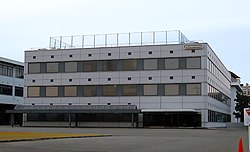Loading AI tools
Former team within Nintendo that developed software and peripherals From Wikipedia, the free encyclopedia
Nintendo Research & Development No. 2 Department,[a] commonly abbreviated as Nintendo R&D2, was a Japanese team within Nintendo that developed software and peripherals. While usually occupied in system operating software and technical support, the team would come back to early development in the 1990s where several new designers got their start at game development, the most famous being Eiji Aonuma who developed Marvelous: Another Treasure Island.
Nintendo's logotype, used during R&D2's existence | |
 Exterior of the former Nintendo headquarters in Kyoto, Japan, which housed the department | |
Native name | 任天堂開発第二部 |
|---|---|
Romanized name | Nintendō Kaihatsu Daini Bu |
| Company type | Department |
| Industry | Video games |
| Genre |
|
| Predecessor | Nintendo Research & Development |
| Founded | 1978 |
| Founder | Hiroshi Yamauchi |
| Defunct | 2004 |
| Fate | Absorbed into Nintendo Software Planning & Development |
| Successor | Nintendo Software Planning & Development |
| Headquarters | Kyoto , Japan |
Number of locations | 1 (Kyoto) (2004) |
Key people |
|
| Owner | Nintendo |
| Parent | Nintendo Manufacturing Division |
R&D2 was originally led by Masayuki Uemura, who previously worked for Sharp Corporation, using an idea of Sharp's solar technology Uemura's department went on to develop the popular Nintendo beam gun games, selling over 1 million units. Kazuhiko Taniguchi took Uemura's position in 2004. Nintendo R&D2 was later merged into Nintendo SPD.[1]
In the 1970s, Nintendo created the R&D2 department.[2]
In 2004, the department's general manager Masayuki Uemura retired from Nintendo.[3][4] Following his retirement, he became a professor at the Ritsumeikan University in Kyoto, and served as an advisor to Nintendo Research & Engineering.[5]
| Year | Name | Ref. |
|---|---|---|
| 1977 | Color TV-Game 6 | [6] |
| Color TV-Game 15 | [6] | |
| 1978 | Color TV-Game Racing 112 | [6] |
| 1979 | Color TV-Game Block Breaker | [6] |
| 1980 | Computer TV-Game | [6] |
| Year | Name | Ref. |
|---|---|---|
| 1983 | Family Computer | [6] |
| 1985 | Nintendo Entertainment System | [6] |
| 1990 | Super Famicom | [6] |
| 1991 | Super Nintendo Entertainment System | [6] |
| 1995 | Satellaview | [6] |
Seamless Wikipedia browsing. On steroids.
Every time you click a link to Wikipedia, Wiktionary or Wikiquote in your browser's search results, it will show the modern Wikiwand interface.
Wikiwand extension is a five stars, simple, with minimum permission required to keep your browsing private, safe and transparent.